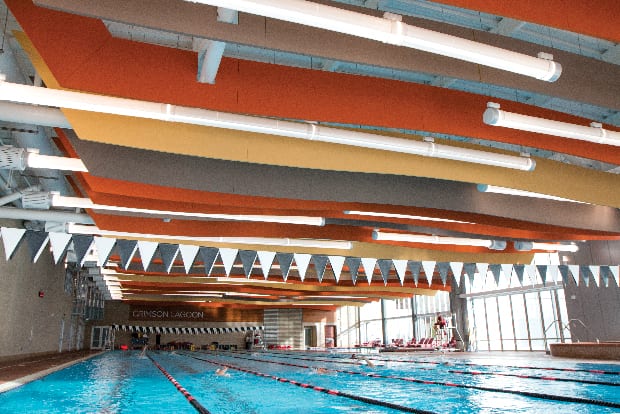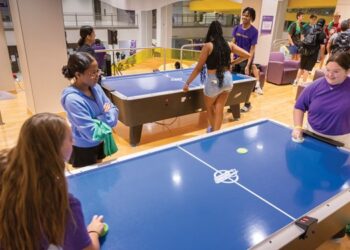Spectacular is the word Mary Bohlig, the director of campus recreation at the University of Utah, used to describe her surroundings.
So it’s no wonder why they brought the outdoors in during the design phase of the Student Life Center. Whether it was through different materials and their application, nods to the mountain terrain or red rock via the color palette, or how it looks like you’re walking through a slot canyon in the fitness studio hallway, Utah’s scenery is engrained throughout the center.
Spectacular could also describe the day the center opened in 2015: “We crashed university servers because we had so many people trying to tap in,” recalled Bohlig. “[The Student Life Center] is something the students at the University of Utah had worked on for well over a decade to make happen.”
Cheri Jenkins, the associate director of operations, explained the center was a huge upgrade. Not only did it provide them more space – which has increased their program offerings – but it also brought together a team that had been scattered across three buildings.
The cohesiveness formed from this is one of the things that stood out to Julian Gomez, the associate director for communications and outreach. “What makes us unique I suppose is we have a really cohesive department,” he explained. “We’re lucky we have a unique set of individuals that are all here for the same reason.”
Now, everyone is in the same building. At its center, Jenkins said they have The Core, a large fitness area that is continually the busiest section of the building, holding both strength and cardio equipment. “We really wanted to build a building that was really functional and is really what the students wanted,” she said.
The Student Life Center also boasts a 50-meter swimming pool. It allows for versatility in programming, whether that’s opening it up for lap swims or dividing it up to allow for activities like water polo or Kayak Roll clinics.
Visibility for campus recreation has overall increased, which was a huge factor for the center’s Outdoor Adventure Program. While the program had been housed in a building on the outskirts of campus, its lobby is now one of the main entry points into the Student Life Center. Both the rentals and trips are heavily used, shared Bohlig.
In fact, Brian Wilkinson said the Outdoor Adventure Program teaches students life skills and impacts in ways only it can. “It’s the most meaningful program students can participate in,” said Wilkinson, an associate director of campus recreation.
He explained during his 20 years in the Outdoor Adventure Program, he saw students learn how to camp, cook, get along with others, etc. Some didn’t even know how to cut an onion prior to a trip with the program. But through the experience, they were taught invaluable lessons.
In Spring 2018, Bohlig estimates they will run about 40 trips by the end of the semester. And to do so means they need amazing program managers who really understand the
industry. “They are very conscientious in terms of listening to the people who rent and then who also participate in trips,” said Bohlig.
Trusting students to take other students out to do ice climbing and mountaineering is a big deal, said Wilkinson. While it’s been incredible having the university risk manager behind the programs, Wilkinson said that could not have been the case. One of the first things he did while in the Outdoor Adventure Program was send the risk manager to a conference hosted by NOLS and Outward Bound. There, Wilkinson said he saw how others were performing these trips safely. “That paid off 100 times,” said Wilkinson.
But behind the new building and the Outdoor Adventure Program is the crew who runs it all – specifically, the Crimson Crew, a program begun 3.5 years ago.
Modeled after Team Mizzou at the University of Missouri, the Crimson Crew is essential to the Student Life Center, which means hiring and training are taken seriously. “For us, that’s a huge program in and of itself,” said Gomez. “We try to make sure we don’t just hire students that want a regular job. We bring them in and we train them. It’s formal recruiting.”
Students have to attend a recruitment session led by Wilkinson in order to even get an application for a role on the Crimson Crew. Their first interview is with two members of the Crimson Council – a group made up of two Crew members from each of the Student Life Center’s activities areas – and each member is taught how to give a tour of the building. Plus, the Crimson Council will decide on workshop topics to offer to Crew members each semester. “Crew members can come and they get paid to learn time management, money management, how to study for finals, effective test taking techniques, personal safety and awareness,” said Wilkinson.

Being under one roof has also benefited the Crimson Crew, shared Gomez, as it’s helped with programming and connection. “Moving into this new building has really helped us with being focused and moving forward, and to help our students and create that student success,” he said.
While it took about 15 years from the time the Student Life Center was originally proposed to the month it opened, Bohlig said the team has continued to come in and perform daily. “They just continue to come in everyday, work their magic,” she said. “They are so dedicated. They are so excited to be in the new building and wanting to make sure the facility, the services and the program are equal to the facility we built.”
But the drive behind working their magic comes down to making a difference in students’ lives. Gomez said to view all you do as making a difference down the road. “Keep in mind everything you do is for the students and that the ultimate goal is student success,” he shared.
In the end, student success should continue long after they walk through your doors for the last time; and hopefully, campus recreation made an impact so they, like Utah’s scenery, can be something spectacular. “We are here for the students, to empower them, to get them ready for the real world,” said Jenkins. “We really are here to make the student experience a better experience, make it higher quality, more well rounded and have the students be really proud of being part of the University of Utah.”













